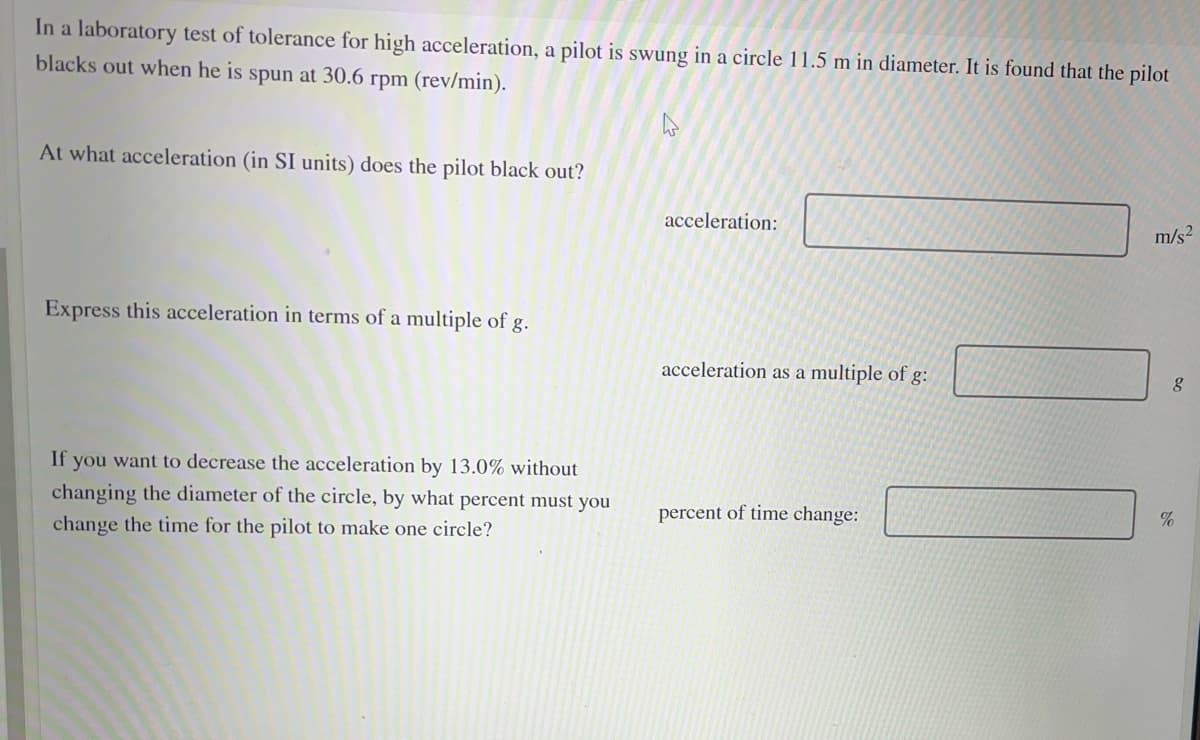In a laboratory test of tolerance for high acceleration, a pilot is swung in a circle 11.5 m in diameter. It is found that the pilot blacks out when he is spun at 30.6 rpm (rev/min). At what acceleration (in SI units) does the pilot black out? Express this acceleration in terms of a multiple of g. If you want to decrease the acceleration by 13.0% without changing the diameter of the circle, by what percent must you change the time for the pilot to make one circle? acceleration: acceleration as a multiple of g: percent of time change: m/s² %
In a laboratory test of tolerance for high acceleration, a pilot is swung in a circle 11.5 m in diameter. It is found that the pilot blacks out when he is spun at 30.6 rpm (rev/min). At what acceleration (in SI units) does the pilot black out? Express this acceleration in terms of a multiple of g. If you want to decrease the acceleration by 13.0% without changing the diameter of the circle, by what percent must you change the time for the pilot to make one circle? acceleration: acceleration as a multiple of g: percent of time change: m/s² %
Principles of Physics: A Calculus-Based Text
5th Edition
ISBN:9781133104261
Author:Raymond A. Serway, John W. Jewett
Publisher:Raymond A. Serway, John W. Jewett
Chapter3: Motion In Two Dimensions
Section: Chapter Questions
Problem 5OQ: Does a car moving around a circular track with constant speed have (a) zero acceleration, (b) an...
Related questions
Concept explainers
Topic Video
Question

Transcribed Image Text:In a laboratory test of tolerance for high acceleration, a pilot is swung in a circle 11.5 m in diameter. It is found that the pilot
blacks out when he is spun at 30.6 rpm (rev/min).
At what acceleration (in SI units) does the pilot black out?
Express this acceleration in terms of a multiple of g.
If you want to decrease the acceleration by 13.0% without
changing the diameter of the circle, by what percent must you
change the time for the pilot to make one circle?
acceleration:
acceleration as a multiple of g:
percent of time change:
m/s²
%
Expert Solution
This question has been solved!
Explore an expertly crafted, step-by-step solution for a thorough understanding of key concepts.
This is a popular solution!
Trending now
This is a popular solution!
Step by step
Solved in 2 steps

Knowledge Booster
Learn more about
Need a deep-dive on the concept behind this application? Look no further. Learn more about this topic, physics and related others by exploring similar questions and additional content below.Recommended textbooks for you

Principles of Physics: A Calculus-Based Text
Physics
ISBN:
9781133104261
Author:
Raymond A. Serway, John W. Jewett
Publisher:
Cengage Learning

University Physics Volume 1
Physics
ISBN:
9781938168277
Author:
William Moebs, Samuel J. Ling, Jeff Sanny
Publisher:
OpenStax - Rice University

Principles of Physics: A Calculus-Based Text
Physics
ISBN:
9781133104261
Author:
Raymond A. Serway, John W. Jewett
Publisher:
Cengage Learning

University Physics Volume 1
Physics
ISBN:
9781938168277
Author:
William Moebs, Samuel J. Ling, Jeff Sanny
Publisher:
OpenStax - Rice University